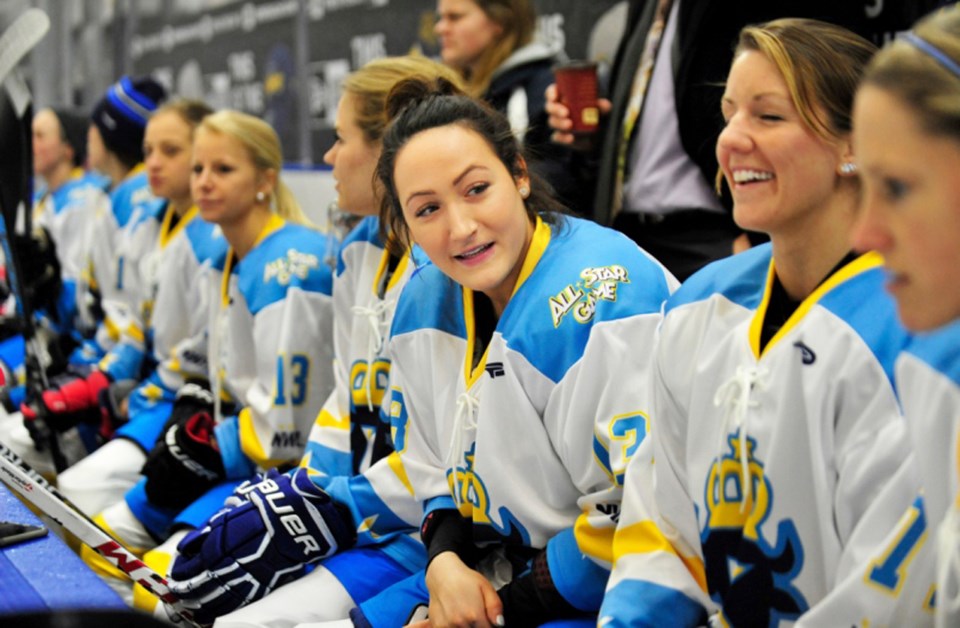Kaleigh Fratkin is learning about the business of hockey, and loving it.
While the inner workings of sports often are tainted by ripe politics, life-changing trades, personal grudges and penny-wise decisions, Fratkin’s classroom is one of a new enterprise, filled with growth potential and unabashed enthusiasm. There are many doors to knock on and pieces of a ceiling to break through, but the smiles on fans – especially the young girls who are discovering new idols and dreams to cheer on – is a great affirmation.
Welcome to the world of women’s pro hockey.
One of the off-season’s top free agent signings of the New Jersey-based New York Riveters, the 24-year-old defenceman is eagerly anticipating the experience of building an on-ice winner, bonding with her new teammates and helping grow the game.
“I’m not making P.K. Subban’s salary but it’s great, great being paid a salary to play,” said Fratkin. “Just the fact that they’re making a point to pay players a salary, something you can pay the rent and live on, as opposed to a stipend to cover gas and food, is wonderful.
“It’s good to just feel like we’re pros.”
Being at the forefront of a new opportunity like the National Women’s Hockey League has its benefits, even though the starting point isn’t lucrative by any sense.
Last year as a rookie she made $20,000 US with the Connecticut Whale, the highest pay among the nearly two-dozen Canadians skating in the league. Her wage remains the same this season, with the league still focusing on expanding its brand and attracting more fans. The top salary is $25,000.
A former member of the Canadian national women’s development team and Canada’s under-18 team, Fratkin topped all defencemen in scoring last year.
As a star player in the two-year-old league, Fratkin said the excitement of being part of a venture where opportunities are still being established for trailblazing women hockey players is palpable.
“It’s pretty busy but awesome,” Fratkin told the NOW in a phone interview. “There’s a lot of stuff going on, the league is building from the ground up. The second season is starting to come together and I’m excited to be with my new team.”
Last year’s inaugural season of the NWHL had Fratkin anchoring the Whale’s blueline and making a smooth transition from her college days where she starred with Boston University’s women’s program. It came after she spent one year in the Canadian amateur women’s league playing for a team based in Boston.
News of a U.S. east coast pro league, which would pay its players, had been a quiet rumour. Suddenly, when it officially was unveiled, Fratkin jumped at the chance and signed with the Whale.
She admitted that while the idea sounded great, there were a lot of questions prior to taking to the ice for the first game.
“From when I signed (in May 2015) until October you were really in the dark about everything – is this a crazy idea? What am I getting myself into? Is this a joke?
“It wasn’t until the first game where we had 1,100 people come out, fill the stands that only seated 900 and line the wall, just to support us,” Fratkin recalled. “They were all excited, grown-ups, kids – I thought, ‘Wow, this is really something.’”
While the Whale jumped out to a great start, winning its first nine games, a surprise coaching change and management issues ended up weighing the team down come playoff time. But before that, Fratkin received a number of honours, including selected to the NWHL’s first all-star game – where she donned a mascot Chicken head during the skills competition – and was picked up by the Boston Pride to play in the NHL Outdoor Classic’s women’s hockey game at Gillette Stadium.
Although the salary isn’t a living wage, it is an important first step. And to be on the ground floor of something and helping it grow is something the Burnaby native embraces. After all, a few years ago the options for a female hockey player, when college ends, were just to pay to play, like any rec hockey player, or quit.
“(After college) I didn’t even know if I’d continue playing,” she said. “At that time I was only 23 and was trying to understand how could I be done playing hockey at that age. It didn’t make sense.
“Prior to (the NWHL), it was one of two things: you played NCAA hockey, or if you were fortunate enough you played in the (Canadian) national women’s program. When I got a Div. I scholarship, I was just so happy.”
While she’s eager to utilize her university degree in broadcast journalism – she’s covered the Boston Red Sox and Hockey East in the past – playing and promoting the fledgling pro league is something she’s proud of. There’s also that thing which got her involved in the sport in the first place. She loves it.
“That’s why I’m still playing,” she said. “People ask if I’m not making a lot of money why am I still playing. The big thing for me is I don’t want to give it up. I love it.
“If I can play a part in growing the sport where girls down the road can play and not have to take a second job, that’s satisfying.”



